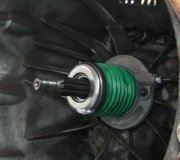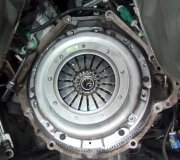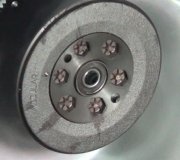#16-73-01: clutch pedal noise/squeak install greaseable stud - (mar 1, 1995)
Revision: 02/23/95
This bulletin is being revised to add 1992-95 model years and to update parts information. Previous divisional publication numbers were:
Chevrolet 91-197a-7c gmc truck 91-7c-164 gm canada 91-7050101
********************************************************************* subject: clutch pedal noise, squeak (install greaseable stud)
Models: 1984-95 chevrolet and gmc truck s/t models with borg-warner 5 speed manual transmission (ml2, ml3, mw1) and 2.2l, 2.5l, or 2.8l engines (vins e, r, a, 4 - rpos ln2, l38, ln8, ll2)
Condition:
Some owners may experience a clutch pedal squeak. This noise usually stops when a slight amount of pressure is applied to the clutch pedal.
Cause:
The noise or squeak is caused by a dry contact area between the clutch fork and ball stud. This results in metal to metal contact.
Correction:
Install a greaseable ball stud. Greaseable ball studs entered production december 1994 and can be identified by a grease fitting on the right side of the clutch housing.
Service procedure:
1. Remove transmission, slave cylinder, flywheel housing and clutch fork.
-complete removal directions can be found in sections 7b and 7c of the appropriate s/t service manual.
2. Remove the ball stud from the flywheel housing.
3. Inspect the flywheel housing (figure 1) and locate the raised ball stud mounting area.
-raised area will appear on the outside of the flywheel housing (figure 1).
-a mold parting line crosses this raised area horizontally dividing it into approximately an upper and lower half (figure 2).
4. Determine location for grease zerk mounting hole (figure 2).
-the hole should be located approximately 1/16 in. (1.5 mm) to the bottom of the mold parting line and within an area of 11/16 - 1-1/8 in. (17.5 - 28.5 mm) of the transmission mounting surface.
-a hole less than 11/16 in. (17.5 mm) from the transmission mounting surface may not enter the ball stud cavity and a hole greater than 1-1/8 in. (28.5 mm) may contact the threaded end of the ball stud.
-the grease zerk used should have no more than 1/4 in. (6.4 mm) of threaded length to avoid entering the ball stud cavity.
5. Drill a hole of required size (determined by diameter/thread pitch of zerk used) in location determined in step 4.
Important: the wall thickness in this area is approximately 1/4". Use caution to prevent passing through ball stud cavity when drilling through the inner wall of the housing.
6. Tap the grease zerk hole (thread size is determined by the grease zerk). Install the grease zerk and the predrilled ball stud (p/n 15679715).
-tighten ball stud to 35 lbs. Ft. (47 n.M.).
Important: thoroughly clean out all metal chips before installing zerk and ball stud to prevent plugging the predrilled ball stud.
7. Grease the zerk fitting until a small amount of grease flows from the end of the ball stud.
8. If the clutch fork shows signs of wear, install a new clutch fork (p/n 15704443). Reinstall the clutch housing, slave cylinder and transmission.
-complete installation directions can be found in sections 7b and 7c of the appropriate s/t service manual.
9. Grease the assembled ball stud lightly through zerk fitting. Grease zerk every 15,000 miles thereafter.
Notice: care should be taken to use only enough grease to keep the fork from squeaking. Excessive greasing can contaminate the clutch disc friction surfaces resulting in slip or chatter and the need to replace the disc.
10. Provide the owner of the vehicle with a copy of the document on the last page of this bulletin.
Service parts information quantity part number description required 15679715 predrilled ball stud 1 15704443 clutch fork 1
SPONSORED LINKS
Was this helpful?
Yes
No
+2
Thursday, February 7th, 2019 AT 10:54 AM
(Merged)



